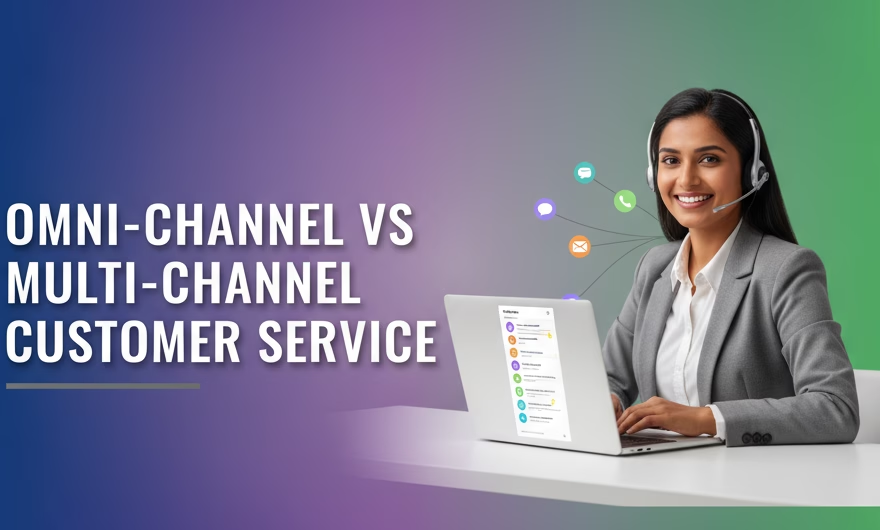When talking about customer service today, two major approaches come up often: omni-channel and multi-channel service. While they may sound similar, they represent fundamentally different strategies for engaging with customers. As customer expectations continue to rise in 2025, the distinction matters even more.
Customers want fast, convenient support on their terms—and they expect the experience to feel connected no matter where it starts.
Here’s what sets them apart:
Multi-Channel Customer Service
The term ‘Multi-channel’ means exactly what it sounds like—many channels. Companies offering multi-channel customer service provide support through various touchpoints such as social media, web, email, phone, and more. The goal is to ensure customers can reach out through their preferred medium. However, there is a key limitation—the channels operate independently, often without integration.
- No seamless integration between channels: Each channel typically has its own queue, tools, and workflows, which can create silos.
- No consistency in the service experience across touchpoints: Policies, tone, and resolution paths may differ from one channel to another.
- Customers may need to repeat information when switching channels: Agents often lack the full context of prior interactions when a conversation moves.
- Limited visibility for agents and managers: It’s difficult to see the entire customer journey, making root-cause analysis and personalization harder.
- Channel-level reporting dominates: Success is measured per channel (e.g., email response time, phone AHT) rather than across the journey, which can optimize parts while harming the whole.
- This approach often fails to bridge the gap for tech-savvy, multi-device users like millennials: When customers switch devices or channels mid-issue, the experience can feel fragmented.
Multi-channel service can be seen as a tactical approach: it broadens your reach, but doesn’t unify the customer journey. It’s useful for organizations taking first steps into digital support or those with simple, transactional inquiries that rarely require channel switching. But as complexity grows—think troubleshooting, billing disputes, order modifications—the lack of integration becomes a source of friction for both customers and agents.
Omni-Channel Customer Service
Omni-channel customer service, on the other hand, is all about integration and consistency—often delivered via an omnichannel contact center. Here, ‘Omni’ means ‘all’—indicating that the strategy covers every possible channel and device, and more importantly, ensures that all these channels are connected. Instead of managing channels separately, omni-channel aligns them around the customer, so conversations continue naturally wherever the customer goes.
- All channels are unified under a single customer view: Profiles, preferences, and interaction history live in one place and are accessible to every agent.
- Customers can switch between channels without losing context: A chat can escalate to a call or move to email with full continuity—no starting over.
- Service is personalized and consistent, regardless of the communication medium: Messaging, policies, and resolutions align to the same standards and knowledge base.
- Agents have a full history of customer interactions, enabling quicker, more relevant responses: Context-aware routing, notes, and transcripts reduce handle time and improve first-contact resolution.
- Works across synchronous and asynchronous channels: Real-time channels (voice, live chat) and asynchronous channels (email, SMS, messaging apps like WhatsApp API, social DMs) are connected, so the conversation can pause and resume without losing momentum.
- Shared workflows and SLAs: Regardless of entry point, the same processes and service levels guide every interaction, improving predictability and trust.
This integrated approach is strategic—it anticipates the customer’s needs and moves them smoothly through their journey, whether they’re on a smartphone, tablet, or desktop. It also improves operations: agents spend less time gathering context and more time solving problems, while leaders can see bottlenecks across the entire journey and prioritize fixes that move the needle on both satisfaction and cost.
Key Comparative Insights
- Philosophy: Multi-channel service is about offering multiple, often unconnected options—like having separate phone, email, and chat teams. Omni-channel service is about connecting all these channels, so the customer experience is seamless from start to finish.
- Data and context: Multi-channel often stores data per channel; omni-channel unifies profiles, conversation history, and preferences so context follows the customer.
- Agent experience: In multi-channel, agents pivot between disparate tools and incomplete histories. In omni-channel, agents work from a single pane of glass with full context, which boosts productivity and reduces errors.
- Measurement: Multi-channel focuses on channel metrics (AHT, response time). Omni-channel complements these with journey metrics (time-to-resolution across channels, repeat contact rate, containment without escalation) for a truer picture of CX.
- Personalization: Multi-channel can personalize within a channel; omni-channel personalizes across channels, using prior interactions to tailor each next step.
- Scalability: Multi-channel scales by adding more agents per channel. Omni-channel scales by orchestrating demand, deflecting intelligently, and routing context-aware interactions to the best resource.
- Business impact: Companies that deliver omni-channel service see higher customer retention—up to 90%—compared to those using multi-channel strategies. See case studies.
- Cost dynamics: The cost of retaining a customer is about 10 times lower than acquiring a new one, making omni-channel a profitable long-term strategy.
To illustrate the real-world difference, consider a common scenario. In a multi-channel setup, a customer starts on chat about a billing issue, is told to call, reaches a phone agent who doesn’t see the chat transcript, and must explain everything again—sometimes repeating the same verification steps and waiting for the same lookups. In an omni-channel setup, the call connects with the transcript attached, the agent sees verification already completed, and can immediately proceed to resolution. The outcome is the same task, but with different effort and emotion—friction versus flow.
Omni-channel also supports more modern customer behaviors. Customers often begin on a mobile device, continue on a laptop, and later follow up via a messaging app. Without a unified foundation—shared identity, synchronized history, and consistent policies—each handoff risks confusion. With omni-channel, those transitions are designed into the journey, so the brand feels reliable, regardless of the path taken.
It’s helpful to think of omni-channel as a customer-centric operating model rather than a set of channels. The building blocks typically include:
- Unified profiles and IDs: A consistent way to recognize customers across channels and sessions.
- Connected conversation history: Transcripts and notes travel with the customer so the next agent can pick up where the last one left off.
- Common knowledge base and policies: The same answers everywhere, reducing rework and contradictions.
- Orchestrated routing: Direct inquiries to the best channel and agent based on context, skills, and customer preferences.
- Cross-channel analytics: Measure the whole journey to uncover the few fixes that improve many outcomes.
By contrast, multi-channel can succeed for straightforward, low-complexity use cases or as a transitional step. But as volumes grow and customer expectations remain high, the lack of integration tends to increase costs (more repeat contacts, longer handle times) and decrease satisfaction (inconsistent answers, repeated explanations).
In Summary
The difference between multi-channel and omni-channel customer service is both tactical and strategic. Multi-channel broadens your reach, but omni-channel delivers a unified, personalized experience—resulting in higher customer satisfaction, loyalty, and business growth. In an environment where customers expect continuity and convenience across every interaction, omni-channel is the approach that aligns teams, tools, and data around what matters most: making each next step effortless for the customer.




